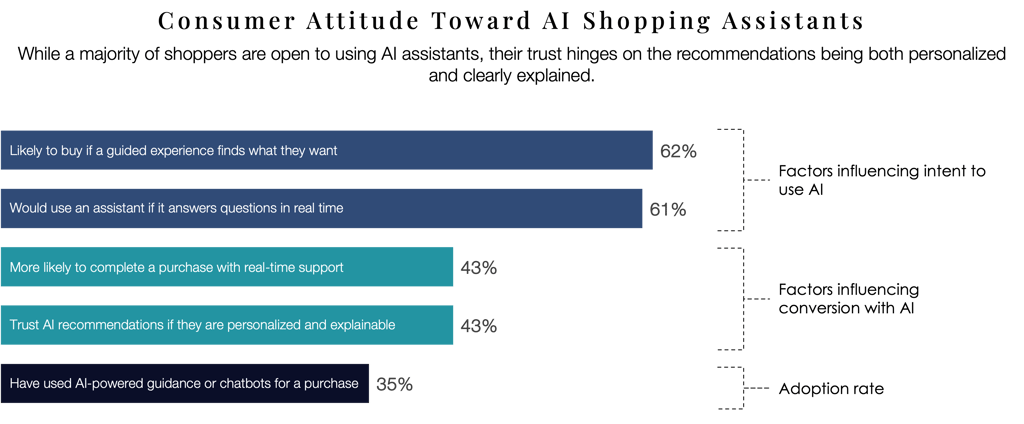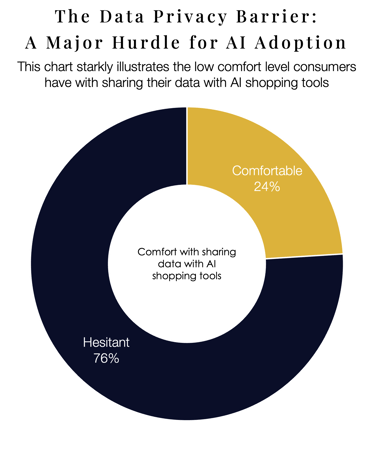The Trust Algorithm: AI in Personalisation vs. Consumer Privacy
Learn how to navigate the complex relationship between AI in personalisation and consumer privacy. This guide helps retail business owners build trust while delivering hyper-personalized experiences.
AI IN RETAIL AND ECOMMERCE
Garret Farmer-Brent
8/5/2025


The modern customer has sent retailers a clear and contradictory message: "Know me, but don't watch me." They crave the magic of a perfectly timed recommendation and the convenience of a shopping experience that anticipates their needs. Yet, they are more suspicious than ever about how their personal data is being collected, used, and protected.
This is the central paradox facing every ecommerce business owner today. The very tool that unlocks unprecedented growth—AI in personalisation—is also the one that can trigger the most significant customer backlash if mishandled.
Successfully deploying AI is no longer just a technical challenge; it's a trust challenge. Retailers who master the delicate balance between hyper-personalization and privacy will build unbreakable customer loyalty. Those who get it wrong risk becoming another cautionary tale.
The Pull of Personalization: Why Customers Want AI
Despite their privacy concerns, consumers have a clear appetite for the benefits that AI-powered personalization delivers. They are tired of sifting through irrelevant products and generic marketing. They want retailers to cut through the noise and guide them to what they're looking for, and they're willing to engage with AI that does this effectively.
The data shows that trust isn't an absolute "yes" or "no." It's conditional. Customers will place their faith in AI-powered recommendations, but that trust must be earned through relevance and transparency.


Source: Arlington Research as cited by Coveo
This data tells a powerful story. Customers are not anti-AI; they are anti-irrelevance and anti-opacity. A successful AI in personalisation strategy is one that feels like a helpful, expert concierge, not an intrusive, invisible tracker.
A Rising Tide of Concern about AI Privacy
For every customer delighted by a spot-on recommendation, there's another who feels unsettled. The headlines are filled with stories of data breaches and misuse, and consumer concern about AI tools is significant and persistent. This skepticism is the single biggest barrier to adopting a truly effective personalization strategy.
Retailers must confront a stark reality: no matter how sophisticated your AI model is, it's useless if customers are unwilling to share the data that fuels it.


Source: EMARKETER and CivicScience
This 76% figure should be a wake-up call. It represents a massive trust deficit that retailers must overcome. The path to successful AI in personalisation is paved with robust privacy protections and transparent practices.
Is your retail business ready for the next upgrade to you technology mix – but you don't know where to start?
A 3-Step Framework for Retailers to Implement their AI personalisation strategy
Navigating this paradox requires a clear, customer-centric framework. Building trust isn't about a single feature; it's an ethos that should permeate your entire AI strategy.
1. Give the Customer Control
The feeling of powerlessness is a major driver of privacy concerns. To counteract this, put the customer firmly in the driver's seat.
Explicit Opt-Ins: Don't assume consent. Ask customers explicitly if they want a personalized experience and explain the benefits.
Easy Opt-Outs: Make turning off personalization features simple and accessible. The ability to say "no" is a powerful trust-builder.
Preference Centers: Allow users to fine-tune their personalization, telling you what they want to see more or less of.
2. Prioritize Radical Transparency
Mystery is the enemy of trust. Be open and honest about how you're using AI and customer data.
Explainable AI: When your AI makes a recommendation, explain why. Simple phrases like "Because you liked [Product A]" or "Inspired by your browsing history" demystify the process. 43% of consumers explicitly state this is a condition for their trust.
Clear Data Policies: Avoid burying your data usage policies in dense legal documents. Create a simple, easy-to-understand summary that explains what data you collect and how it's used to improve their experience.
3. Demonstrate Value and Security
Ultimately, customers will trade data for tangible benefits, but only if they believe their information is secure.
Lead with Value: Ensure your personalization efforts solve real problems. Help customers find products faster, discover unique items, or get better deals.
Highlight Security: Proactively communicate the steps you're taking to protect customer data. Display security badges and certifications prominently. Emphasize that privacy is a top priority.
Personalization and Privacy: Two Sides of the Same Coin
The future of retail will be defined by the successful implementation of AI in personalisation. But the brands that win will be those who recognize that personalization and privacy are not opposing forces, but two essential components of a single goal: building a trusted, long-term customer relationship.
By adopting a strategy rooted in control, transparency, and value, you can build your own "trust algorithm"—one that not only delivers incredible, personalized experiences but also earns you a customer for life.
Begin your AI business upgrade today by taking our comprehensive AI Readiness Assessment.
You'll receive a full business analysis report at no charge.




